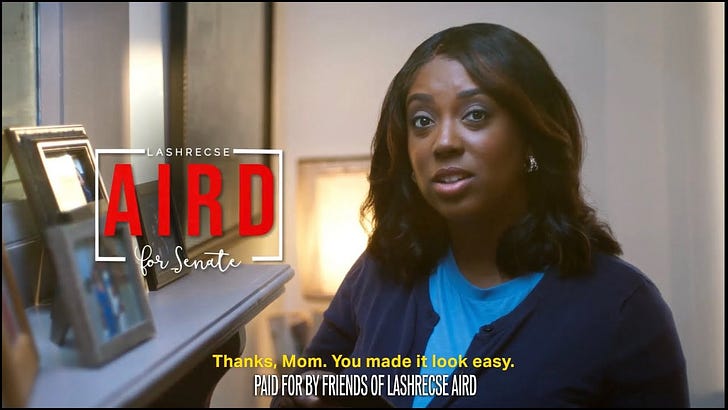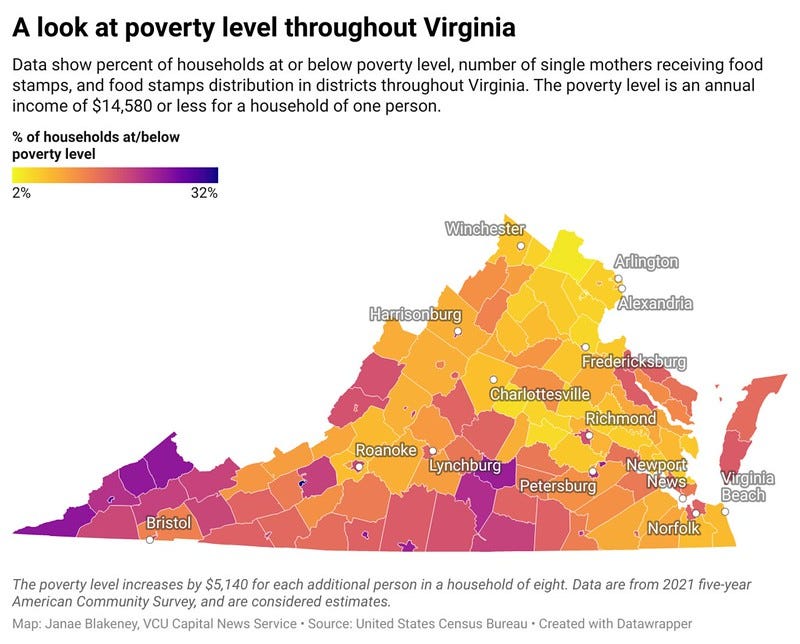Aird released her first TV ad in the primary against Morrissey
Williams also released an ad in the primary against March.
This is the Virginia Scope daily newsletter covering Virginia politics from top to bottom. Please consider becoming the ultimate political insider by supporting non-partisan, independent news and becoming a paid subscriber to this newsletter today.
Have a tip? You can reply to this email, or email me directly at Brandon@virginiascope.com
Aird released a new ad in the primary race against Morrissey
Lashrecse Aird (D) released her first ad this week for the primary race against Sen. Joe Morrissey (D). The ad will be running on cable broadcasts in the Richmond area.
Morrissey is seeking reelection to the state Senate in SD-13. According to VPAP, 61% of the voters in SD-13 are new to Morrissey after redistricting caused a shift in where legislators are running this year.
Here is a look at the finance numbers from both candidates during the first quarter of 2023:
Lashrecse Aird (D)
Raised: $363,369
COH: $418,117
Her top donors:
$150,000 - Clean Virginia Fund
$75,000 - Sonjia Smith - (Smith is married to Clean Virginia’s founder and funder, Michael Bills.)
$15,000 - Ronald Abramson
$10,000 - David Baldacci
Joe Morrissey (D)
Raised: $72,125
COH: $319,707
His top Donors:
$40,000 - Dominion Energy PAC
$10,000 - Tobacco Company Restaurant
$6,500 - Charles City Timber
$5,000 - Ty's Hauling & Paving Inc.
Williams released an ad in his primary race against March
Del. Wren Williams (R) released an ad in his primary race against Del. Marie March (R). The ad will be running on Fox News and local radio stations around the district.
Williams and March are seeking the Republican nomination for the HD-47 seat after redistricting placed them within the same boundaries.
Fundraising totals for the first quarter of this year:
Marie March (R)
Raised: $3,847
COH: $3,321
Wren Williams (R)
Raised: $76,787
COH: $69,763
Loss of emergency SNAP allotment impacts Southwest Virginia families
By Janae Blakeney, Capital News Service
RICHMOND, Va. ‒ A single mother wheeled her cart around a Roanoke Food Lion on a recent Saturday night, plucking a few staples off the shelves for her and her daughter to eat.
She selected some eggs, milk, frozen Kid Cuisines and other items for the week and headed for the checkout line. She swiped a plastic card for payment, like most customers do, but unlike other customers she used an electronic benefit transfer card, known as food stamp benefits.
The card does not have as many funds on it now as it did two months ago, since a COVID-era support program ended in early March.
Alyssa Leftwich works part time at the Food Lion deli. She is a single mother to her almost 2-year-old daughter.
Leftwich is one of approximately 78,000 households with a mother or caregiver that provides for a child alone and receives food stamps, in Virginia. There are over 3.5 million such households in the U.S., according to 2021 data estimates from the U.S. Census Bureau.
The benefits are a huge help on a low income, Leftwich said.
“You feel overwhelmed and stressed trying to run a household on your own and make sure your child has everything they need,” Leftwich said.
The Supplemental Nutrition Assistance Program provides food stamp benefits that can be used like cash to buy groceries from authorized retailers, according to the Virginia Department of Social Services.
The emergency allotments increased existing monthly benefits to the maximum amount, based on household size, not income limits. The program in April 2020 gave $95 extra to households that received the monthly maximum, according to the Virginia Department of Social Services. Congress passed the Consolidated Appropriations Act this year, which ended emergency allotments after the last February distribution.
“It was able to help me get more food and larger amounts for me and my child,” Leftwich said.
Some families are finding now they do not have enough to cover food expenses.
“Being a single mother is hard; sometimes you don’t have other resources,” Leftwich said.
Leftwich likes to buy half a gallon of milk at the grocery store, but said it seems to go pretty quickly. She has turned to other resources to help feed her daughter and stretch out the food stamp allotment.
Food banks in Roanoke said they are helping more residents — from young mothers to veterans to senior citizens — after the extra benefits ended. But, the food banks also face a decrease in donations due to rising food costs and lack of funds to buy more costly food.
Food banks see need increase
Christian Soldiers Food Pantry of Roanoke is a partner agency of Feeding America, according to Rayma Mills, director and manager of the food pantry. The pantry started 25 years ago from the back of a pickup truck with two pastors, according to Mills, and now occupies a large area upstairs in an old industrial building.
They receive donations almost daily from Food Lion, Kroger, Walmart and Sam’s Club, Mills said.
On an early Friday morning in April, visitors shopped the pantry and chose from shelves stacked with produce, meat, dry goods, bread, desserts and more. That day rotisserie chicken was also offered.
“We serve clients Tuesday through Saturday,” Mills said. “They can come one time a week.”
More people have come to the food bank since emergency allotments ended, according to Mills.
They serve thousands of people a year, according to Mills.
“They’ve taken benefits away, but they’re not putting a net there for nobody,” Mills said.
The food pantry helps people who “fall through the cracks,” she said.
“I have people coming through here that say if they could not come to this pantry, they would not be able to eat, and I know it’s the absolute truth,” Mills said.
Friendship House has operated for 85 years, according to the owner Aaron Dowdy. In addition to a food pantry, the house runs an after-school program for elementary school children, and a housing program for refugees and immigrants, Dowdy said.
“We’ve had several families mention that’s the reason why they’re coming more often now,” Dowdy said about the end of emergency SNAP benefits.
The Friendship House served approximately 115 families a week before 2023. The organization now serves approximately 150 families a week, according to Dowdy.
The pantry gives each family at least two grocery bags of food. One bag has canned goods and the other has fresh food, according to Dowdy.
Food banks struggle to help those in need
United Christian Inner-City Ministry Food Distribution Center of Roanoke has served the community for 23 years, according to owner Billie English.
The Food Distribution Center has had an increase in phone calls since emergency benefits ended. But also due to the rising price of food products, English said. The center also serves people who don’t receive SNAP benefits, English said.
The number of donations to the center have decreased due to the increase in food prices, according to English.
“Our donations have gone down because people are having to spend more money to buy food,” English said. “They’re not able to help donate so that we can go get food.”
Feeding America is a network of food pantries and food banks around the U.S., with seven main locations in Virginia. Feeding America projected a 20% decrease in donations from manufacturers and a 45% decrease in “federal commodities” for last year. The organization stated last year that 55% of their food banks reported a decrease in donations.
Food banks now have to purchase more food to keep up with need, but are paying higher costs, according to Feeding America. The organization estimated a 40% increase in food costs last year.
Rising food costs
The U.S. Department of Agriculture forecast the price of eggs would increase almost 30% this year. Other categories would increase in price also, including meats, poultry, dairy, fats and oils, processed fruits and vegetables, sugar and sweets, and cereals and bakery products.
Food prices are anticipated to increase more slowly this year, but remain at above-historical average rates, according to the USDA, which predicted a 7.5% increase in all food costs this year for the U.S. The Consumer Price Index is a measure of economy-wide inflation. The CPI was up 6% in February from last February, according to the USDA.
Grocery store food prices increased by over 10% from February this year to February 2022, according to the USDA.
Many people in the region do not have the extra money to spare.
The poverty level is an annual income of $14,580 or less for a household of one person in Virginia. The poverty level increases by $5,140 for each additional person in a household of eight, according to the Virginia Department of Health.
Over 18% of households in Roanoke live in poverty. The median Roanoke household income, in dollars adjusted for inflation, is under $49,000, according to data from the U.S. Census Bureau.
Food is a necessary, but significant expense, Leftwich said. Local food banks are beneficial for single mothers like her, she said.
“The food bank has helped me get things I need because the food prices have gone up,” Leftwich said. “They helped me get access to nutritious foods like fresh produce and helped me reduce a financial burden.”






